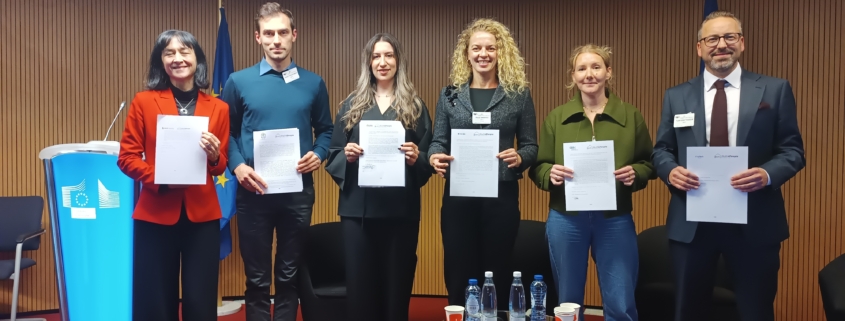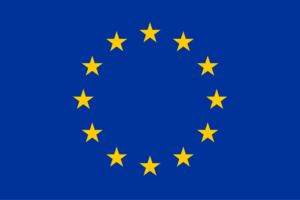The Fourth Built4People Partnership Stakeholders Forum and B4PIC Charter Signature Ceremony
The fourth Built4People (B4P) Stakeholders Forum was held on October 15th, 2025, in Brussels, Belgium. The event focused on innovation-driven affordable housing and the built environment, bringing together more than 80 policymakers, industry leaders, and researchers to discuss the green and digital transition in Europe’s construction sector. A key part of the event was the B4P Innovation Cluster (B4PIC) Charter Signature Ceremony, where new prospective B4PICs signed their charters to join the network.
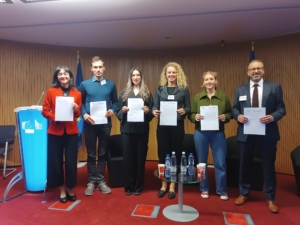
New emerging B4PICs after having signed the B4P Charter.
The event opened with welcoming remarks by Mathieu DALOZE (Policy Officer at DG ENER.B2, European Commission) and Alain ZARLI (ECTP Secretary General), setting the stage for a day dedicated to advancing innovation and sustainability in the built environment. Anastasiya Yurchyshyna (Project & Policy Officer at ECTP) served as the master of ceremonies, guiding the audience through the sessions.
Following the opening, two high-level speeches provided key insights into the future of Europe’s construction and housing landscape. Margareta Djordjevic (Head of Unit – Energy Efficiency: Policy and Financing, DG ENER, European Commission) highlighted the importance of the European Energy Efficiency Directive (EED) and the Energy Performance of Buildings Directive (EPBD), noting that a crucial element of the EPBD is the submission of National Building Renovation Plans by the end of 2025. Djordjevic emphasised that housing must be seen not only as a market commodity but also as a social right, as mentioned in the State of the Union address by Ursula von der Leyen, President of the European Commission. Her intervention stressed the need to balance sustainability, affordability, and energy efficiency, pointing to the forthcoming European Affordable and Sustainable Housing Plan as a key initiative. She underlined that Research and Innovation (R&I) are essential drivers of this transition, and that the European Partnerships under Horizon Europe provide a vital, collaborative framework to achieve these goals.
The second high-level speaker, Edward Woods (Head of R&D, Innovation and Venture Capital at Bouygues Construction, and ECTP President), reflected on the evolution of his organisation: from an R&D-focused team to one integrating innovation and venture capital. Woods underscored the value of open innovation and collaboration across the entire value chain. He emphasised that Built4People Innovation Clusters (B4PICs) are a crucial component of this ecosystem, where partnerships and innovation must ultimately generate sustainable business opportunities.
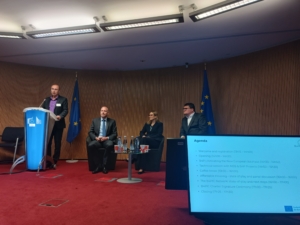
Opening session (from left to right): Alain Zarli, Mathieu Daloze, Margareta Djordjevic and Edward Woods.
The session “Built4People | Activating the New European Bauhaus” featured Emilie Vandam (Policy Officer at JRC.B4 – New European Bauhaus, European Commission), who presented the New European Bauhaus (NEB) as a growing community of bottom-up initiatives across Europe, integrated into EU programmes and policies to promote sustainability, inclusion, and beauty in the built environment. She highlighted the tools and guidelines supporting NEB projects, the ongoing expansion of the community—now involving five Commissioners—and the forthcoming Commission Communication and Council Recommendation reviewing the initiative’s future.
Vandam introduced the new NEB Facility, a dedicated funding instrument providing €120 million annually for R&I to develop NEB solutions and another €120 million for their roll-out and scaling up, and announced the next NEB Festival (9–13 June 2026). Larissa De Rosso (ACE EU Funding and Projects Manager) followed by linking Built4People and the NEB, showing how the facility translates into R&I opportunities. She referred to the BUGA Wood Pavilion as a NEB example, encouraged the use of the NEB Compass and its self-assessment tool, and promoted the Nebula Project’s NEB Handbook, the NEB Community online platform, and the NEB Advisors network.
De Rosso concluded by inviting participants to explore funding opportunities through National Contact Points, the EIT NEB Community, and the NEB Academy, reaffirming ACE’s active role in advancing NEB and B4P objectives.
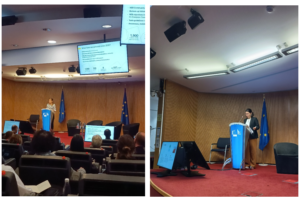
Emilie Vandam and Larissa De Rosso during the “Built4People Activating the New European Bauhaus” session.
Continuing the connection between the two initiatives, the “Technical session with NEB and B4P projects” showcased practical examples of how both frameworks translate policy into innovation. Karine Laffont-Eloire (Dowell Innovation) presented the NEB Junction project, which aims to spread awareness and understanding of the New European Bauhaus, making its principles more accessible and ensuring engagement beyond the usual stakeholders. Fabrizio Tavaroli (RINA) introduced the MULTICLIMACT project, focused on protecting Europe’s built environment from the increasing risks posed by natural and climate-related hazards such as earthquakes, extreme weather, floods, and heatwaves.
Finally, Juan Carlos Guerrero (AIDIMME) presented the SNUG project, which promotes sustainability through the development of eco-friendly materials, the integration of artificial intelligence, and advances in energy efficiency and decarbonisation—all contributing to the shared NEB and B4P vision of a resilient and sustainable built environment.

Logos of the 3 projects presented during the “Technical session with NEB and B4P projects”.
After the coffee break, the session “Affordable Housing – State of Play and Panel Discussion”, moderated by Isabel Pinto-Seppä (VTT) and Anastasiya Yurchyshyna (ECTP), brought together key stakeholders to explore how R&I can drive the transition towards affordable, sustainable housing in Europe. The panel featured Edit Lakatos (Policy Officer, Task Force Housing – DG ENER), Roman Horvath (Policy Officer, Construction Unit – DG GROW), João Gonçalves (SHAPE II project, Housing Europe), and Edward Woods (ECTP President, Bouygues Construction). Discussions centred on the sector’s need to meet multiple objectives—from circularity and infrastructure resilience to digitalisation and the urgent housing demand—while ensuring that R&I results from initiatives and partnerships like Built4People are effectively operationalised and upscaled.
Edit Lakatos presented the work of the newly established Housing Task Force under DG ENER, which coordinates housing-related policies across seven Directorates-General and is preparing the European Affordable Housing Plan, to be unveiled by the end of the year. She emphasised boosting supply, productivity, and investment, supporting vulnerable groups, and updating the definition of social housing within new state aid rules, alongside plans for a regular European Housing Summit.
Roman Horvath underlined the role of the construction ecosystem as an enabler for a greener, more resilient, and digital economy, announcing that the EU Construction Strategy for Housing Supply will also be published by the end of 2025, with a preview to be shared during the upcoming High-Level Construction Forum on 27 October 2025. João Gonçalves highlighted Housing Europe’s collaboration with local and regional partners to tailor solutions to specific contexts, stressing that innovation is key to tackling the housing challenge.He presented several good practice examples collected in the context of the SHAPE II project, including Aalborg East in Denmark, Innovation City Ruhr and Nettelbeckplatz in Germany, and Sociale Energie Sprong in Belgium, as well as examples of other innovative approaches such as the reuse of construction materials, cooperative housing models, repurposing of vacant buildings, and nature-based solutions.
Finally, Edward Woods emphasised the need for systemic and digital solutions, greater standardisation—as a prerequisite for industrialisation—and mass customisation to enhance efficiency and eliminate non-quality, noting that delivering affordable housing requires coordinated effort across the entire value chain, from contractors to real estate developers.
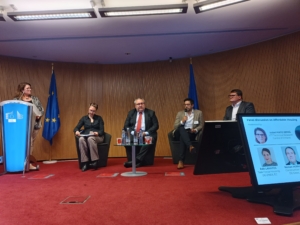
Panel discussion (from left to right): Isabel Pinto-Seppä, Lakatos, Roman Horvath, João Gonçalves and Edward Woods.
Following the panel discussion, Anastasiya Yurchyshyna presented the state of play and next steps of the B4PIC Network, which now encompasses participants from 21 countries across the EU27 and beyond, bringing together a total of 34 B4PICs—18 Emerging and 16 Prospective. Her presentation served as an introduction to the B4PIC Charter Signature Ceremony, a key moment of the event where six prospective B4PICs officially signed their B4PIC Charters, becoming Emerging B4PICs and beginning their journey to implement their roadmaps and advance through the network’s maturity process.
The new signatories were: Centre de Déploiement de l’Écotransition dans les Entreprises et les Territoires (CD2E) – France; CivicLabs – Israel; Intelligent Solutions for Zero and Positive Energy Buildings – Digital Innovation Hub (IsZEB DIH) – Greece; PropTech Sweden – Sweden; Sustainable Environments Ukraine (SE-UA) – Ukraine; and SRIP PSiDL (Smart Buildings and Home with Wood Chain) – Slovenia
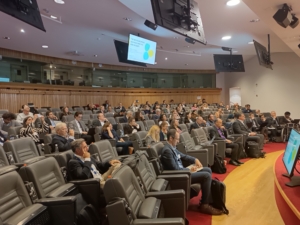
Audience at 4th Built4People Partnership Stakeholders Forum.
The event concluded with closing remarks by Veronika Schröpfer (Project Officer, CINEA), who highlighted the crucial role of Built4People as an interlinking point within the European built environment, connecting projects such as SNUG and MULTICLIMACT under a common vision.
She reminded participants that achieving climate neutrality goes beyond technological innovation—it is equally about engaging people and communities. Schröpfer also underlined the importance of recognising the local diversity of the built environment across Europe, emphasising that place-based approaches are essential to ensure that the green and digital transitions truly meet local needs and realities.
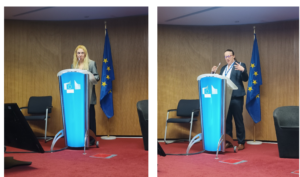
Anastasiya Yurchyshyna and Veronika Schröpfer presenting at the Stakeholder Forum.
Download the presentation here.
And watch now the recording (password: Bu25ReC1510F).

